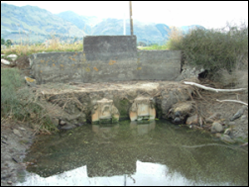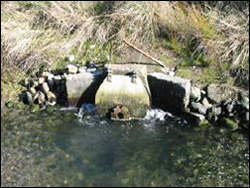Flood gate design and management
Research Status: Ongoing |
Double tidal gate |
Introduction
Concerns from a number of councils around the country over the potential effects of floodgates (or more correctly tidegates) restricting fish passage and altering lowland/coastal habitat have been expressed. There are probably thousands of floodgates around the coastline of New Zealand that were constructed in conjunction with reclamation/development of low lying coastal land. Their primary function is to allow water to flow out to sea during low tides and stop water flowing back upstream during high tides. Most tidegates consist of a solid 'gate' that is hinged at the top and opens up when water pressure builds behind the gate and is closed at other times.
A wide variety of fish species move between freshwater and saltwater areas and the majority of New Zealand's native freshwater fish require access to and from the sea to complete their lifecycle. Coastal margins are also important juvenile rearing areas for some marine fish species. Tidegates represent a significant potential barrier to fish movement since they are closed for much of the time and when open have water velocities that are too fast for fish to negotiate.
The other issue with tidegates is that they facilitate a sudden change from a freshwater habitat to a salt water habitat. This is a problem because key species like inanga spawn in very localised areas near what's called the top of the 'salt water wedge'. At this location tidal fluctuations change the water level, but don't actually make it very salty. Installation of tidegates stops the tidal fluctuation in traditional inanga spawning grounds upstream and other areas downstream of the gates are not suitable because they are too salty.
Research Approach
During the 2006 whitebaiting season we monitored fish movement for 24 hours at two tidegates - one on the western side of the Motueka Rivermouth and one at the outlet of Pearl Creek. The monitoring was done using a DIDSON acoustic camera, which enables you to 'see' through turbid water and/or at night.
Research Results
Some interesting observations were made:
- Inanga were not seeking to pass through the tidegates at night (which matches whitebaiters' assumption that not much migration happens at night).
- The tidegates cause large accumulations of inanga downstream, which are easy targets for predation by large fish (mullet, kahawai, trout), birds and humans.
- Passage was possible at the Motueka tidegate when it was open, but we saw only one eel successfully make it through the tidegate at Pearl Creek.
- Using the DIDSON camera you can estimate water velocities coming though the tidegate. Passage was not observed if water velocities were above 50 cm/s.
 |
 |
A single tidal gate |
Scan from DIDSON scanner |
Recent Publications
Primary Contacts:

|
Trevor James
Email |
Institute Tasman District Council |
Expertise Water Quality and Aquatic Ecology |

|
Rowan Strickland
Email |
Institute Cawthron Institute |
Expertise Coastal and Freshwater Group Manager, Freshwater scientist |

|
Roger Young
Email Phone: (03) 548 2319 Fax: (03) 546 9464 |
Institute Cawthron Institute |
Expertise Land/water interactions, water quality, fisheries, river health |